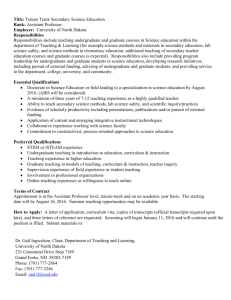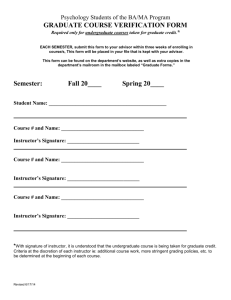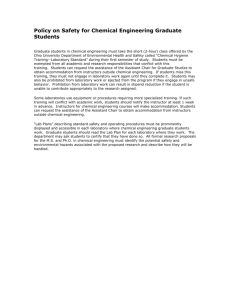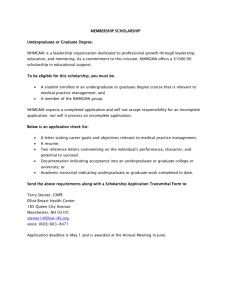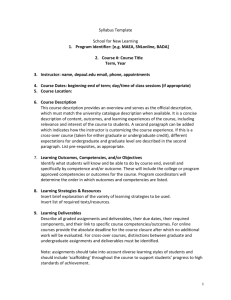Faculty Survey of Student Engagement for Graduate Student
advertisement
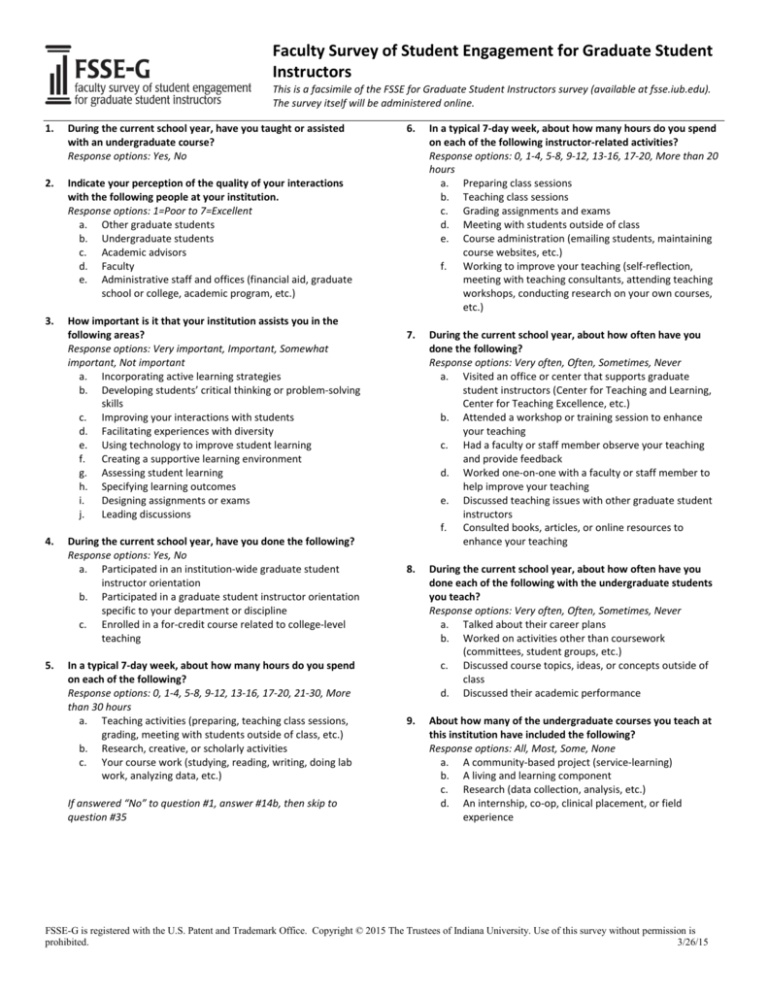
Faculty Survey of Student Engagement for Graduate Student Instructors This is a facsimile of the FSSE for Graduate Student Instructors survey (available at fsse.iub.edu). The survey itself will be administered online. 1. During the current school year, have you taught or assisted with an undergraduate course? Response options: Yes, No 2. Indicate your perception of the quality of your interactions with the following people at your institution. Response options: 1=Poor to 7=Excellent a. Other graduate students b. Undergraduate students c. Academic advisors d. Faculty e. Administrative staff and offices (financial aid, graduate school or college, academic program, etc.) 3. How important is it that your institution assists you in the following areas? Response options: Very important, Important, Somewhat important, Not important a. Incorporating active learning strategies b. Developing students’ critical thinking or problem-solving skills c. Improving your interactions with students d. Facilitating experiences with diversity e. Using technology to improve student learning f. Creating a supportive learning environment g. Assessing student learning h. Specifying learning outcomes i. Designing assignments or exams j. Leading discussions 4. During the current school year, have you done the following? Response options: Yes, No a. Participated in an institution-wide graduate student instructor orientation b. Participated in a graduate student instructor orientation specific to your department or discipline c. Enrolled in a for-credit course related to college-level teaching 5. In a typical 7-day week, about how many hours do you spend on each of the following? Response options: 0, 1-4, 5-8, 9-12, 13-16, 17-20, 21-30, More than 30 hours a. Teaching activities (preparing, teaching class sessions, grading, meeting with students outside of class, etc.) b. Research, creative, or scholarly activities c. Your course work (studying, reading, writing, doing lab work, analyzing data, etc.) If answered “No” to question #1, answer #14b, then skip to question #35 6. In a typical 7-day week, about how many hours do you spend on each of the following instructor-related activities? Response options: 0, 1-4, 5-8, 9-12, 13-16, 17-20, More than 20 hours a. Preparing class sessions b. Teaching class sessions c. Grading assignments and exams d. Meeting with students outside of class e. Course administration (emailing students, maintaining course websites, etc.) f. Working to improve your teaching (self-reflection, meeting with teaching consultants, attending teaching workshops, conducting research on your own courses, etc.) 7. During the current school year, about how often have you done the following? Response options: Very often, Often, Sometimes, Never a. Visited an office or center that supports graduate student instructors (Center for Teaching and Learning, Center for Teaching Excellence, etc.) b. Attended a workshop or training session to enhance your teaching c. Had a faculty or staff member observe your teaching and provide feedback d. Worked one-on-one with a faculty or staff member to help improve your teaching e. Discussed teaching issues with other graduate student instructors f. Consulted books, articles, or online resources to enhance your teaching 8. During the current school year, about how often have you done each of the following with the undergraduate students you teach? Response options: Very often, Often, Sometimes, Never a. Talked about their career plans b. Worked on activities other than coursework (committees, student groups, etc.) c. Discussed course topics, ideas, or concepts outside of class d. Discussed their academic performance 9. About how many of the undergraduate courses you teach at this institution have included the following? Response options: All, Most, Some, None a. A community-based project (service-learning) b. A living and learning component c. Research (data collection, analysis, etc.) d. An internship, co-op, clinical placement, or field experience FSSE-G is registered with the U.S. Patent and Trademark Office. Copyright © 2015 The Trustees of Indiana University. Use of this survey without permission is prohibited. 3/26/15 Faculty Survey of Student Engagement for Graduate Student Instructors 10. In the undergraduate courses you teach at this institution, to what extent do you do the following? Response options: Very much, Quite a bit, Some, Very little a. Clearly explain course goals and requirements b. Teach course sessions in an organized way c. Use examples or illustrations to explain difficult points d. Use a variety of teaching techniques to accommodate diversity in student learning styles e. Review and summarize material for students f. Provide standards for satisfactory completion of assignments (rubrics, detailed outlines, etc.) g. Provide feedback to students on drafts or works in progress h. Provide prompt and detailed feedback on tests or completed assignments 11. How much has your teaching experience at this institution contributed to your ability to do the following with undergraduate students? Response options: Very much, Quite a bit, Some, Very little a. Develop their higher-order learning skills (application, analysis, evaluation, synthesis) b. Promote reflection on their learning c. Promote their ability to integrate knowledge from different courses or experiences d. Develop their quantitative reasoning skills e. Promote their use of effective learning strategies f. Facilitate collaborative learning experiences g. Facilitate discussions with diverse groups of students h. Mentor or advise students i. Use effective teaching practices Please answer the following questions based on one particular undergraduate course section you have taught or assisted with during the current school year, including courses in the current term. 12. What was your teaching role for this course? (Select all that apply.) a. Course instructor b. Lab instructor c. Lecture or discussion instructor d. Reader or grader e. Tutor f. Other, please specify: 13. What is the general academic discipline of your selected course section? Write in 14. Is your selected course section in the same academic discipline as the degree you are currently pursuing? Response options: Yes, No If No: In what academic department are you pursuing your degree? Write-in 15. What is the class level of most students in your selected course section? Response options: Lower division (mostly first-year students or sophomores), Upper division (mostly juniors or seniors); Other, please describe: 16. Estimate the total number of students in your selected course section. Response options: 20 or fewer, 21-30, 31-40, 41-50, 51-100, More than 100 17. Does your selected course section fulfill a general education requirement on your campus? Response options: Yes, No, I don’t know 18. In what format do you teach your selected course section? Response options: Classroom instruction on-campus; Classroom instruction at an auxiliary location (satellite campus, rented facility, etc.); Distance education (online, live or pre-recorded video or audio, correspondence, etc.); Combination of classroom instruction and distance education 19. In your selected course section, how much do you control the following? Response options: Very much, Quite a bit, Some, Very little a. Purpose and goals b. Content c. Instructional materials d. Instructional activities e. Assessment (tests, evaluations, surveys, polls, etc.) 20. In an average 7-day week, about how many hours do you expect the typical student to spend preparing for your selected course section (studying, reading, writing, doing homework or lab work, analyzing data, rehearsing, and other academic activities)? Response options: 0, 1, 2, 3, 4, 5, 6, 7, 8, 9, 10, More than 10 hours 21. In an average 7-day week, about how many hours do you think the typical student actually spends preparing for your selected course section (studying, reading, writing, doing homework or lab work, analyzing data, rehearsing, and other academic activities)? Response options: 0, 1, 2, 3, 4, 5, 6, 7, 8, 9, 10, More than 10 hours 22a. In an average 7-day week about how many hours do you expect the typical student to spend on assigned reading? Response options: 0, 1, 2, 3, 4, 5, 6, 7, 8, 9, 10, More than 10 hours 22b. If not 0: About how much of the assigned reading in your selected course section do you think the typical student completes? Response options: All, Most, Some, None 23. In your selected course section, to what extent do you think the typical student does his or her best work? Response options: Very much, Quite a bit, Some, Very little FSSE-G is registered with the U.S. Patent and Trademark Office. Copyright © 2015 The Trustees of Indiana University. Use of this survey without permission is prohibited. 3/26/15 Faculty Survey of Student Engagement for Graduate Student Instructors 24. In your selected course section, how important is it to you that the typical student do the following? Response options: Very important, Important, Somewhat important, Not important a. Ask questions or contribute to course discussions in other ways b. Prepare two or more drafts of a paper or assignment before turning it in c. Come to class having completed readings or assignments d. Reach conclusions based on his or her analysis of numerical information (numbers, graphs, statistics, etc.) e. Use numerical information to examine a real-world problem or issue (unemployment, climate change, public health, etc.) f. Evaluate what others have concluded from numerical information 25. In your selected course section, how important is it to you that the typical student do the following? Response options: Very important, Important, Somewhat important, Not important a. Combine ideas from different courses when completing assignments b. Connect his or her learning to societal problems or issues c. Include diverse perspectives (political, religious, racial/ethnic, gender, etc.) in course discussions or assignments d. Examine the strengths and weaknesses of his or her own views on a topic or issue e. Try to better understand someone else’s views by imagining how an issue looks from his or her perspective f. Learn something that changes the way he or she understands an issue or concept g. Connect ideas from your course to his or her prior experiences and knowledge 26. In your selected course section, about what percent of class time is spent on the following? Response options: 0%, 1-9%, 10-19%, 20-29%, 30-39%, 40-49%, 50-74%, 75% or more a. Lecture b. Discussion c. Small-group activities d. Student presentations or performances e. Independent student work (writing, painting, designing, etc.) f. Movies, videos, music, or other performances not involving or produced by students g. Assessing student learning (tests, evaluations, surveys, polls, etc.) h. Experiential activities (labs, field work, clinical or field placements, etc.) 27. In your selected course section, how much do you encourage students to do the following? Response options: Very much, Quite a bit, Some, Very little a. Ask other students for help understanding course material b. Explain course material to other students c. Prepare for exams by discussing or working through course material with other students d. Work with other students on course projects or assignments e. Identify key information from reading assignments f. Review notes after class g. Summarize what has been learned from class or from course materials 28. In your selected course section, how much opportunity do students have to engage in discussions with people from the following groups? Response options: Very much, Quite a bit, Some, Very little a. People of a race or ethnicity other than their own b. People from an economic background other than their own c. People with religious beliefs other than their own d. People with political views other than their own e. People with a sexual orientation other than their own 29. In your selected course section, how much does the coursework emphasize the following? Response options: Very much, Quite a bit, Some, Very little a. Memorizing course material b. Applying facts, theories, or methods to practical problems or new situations c. Analyzing an idea, experience, or line of reasoning in depth by examining its parts d. Evaluating a point of view, decision, or information source e. Forming a new idea or understanding from various pieces of information 30a. Does your selected course section include assigned papers, reports, or other writing tasks? Response options: Yes, No If not No: About how many papers, reports, or other writing tasks of the following lengths do you assign? Response options: 0, 1, 2, 3, 4, 5, 6, 7, 8, 9, 10, More than 10 papers, etc. 30b. Up to 5 pages 30c. From 6 to 10 pages 30d. 11 pages or more FSSE-G is registered with the U.S. Patent and Trademark Office. Copyright © 2015 The Trustees of Indiana University. Use of this survey without permission is prohibited. 3/26/15 Faculty Survey of Student Engagement for Graduate Student Instructors 31. In your selected course section, how much do your students learn and develop in the following areas? Response options: Very much, Quite a bit, Some, Very little a. Writing clearly and effectively b. Speaking clearly and effectively c. Thinking critically and analytically d. Analyzing numerical and statistical information e. Acquiring job- or work-related knowledge and skills f. Working effectively with others g. Developing or clarifying a personal code of values and ethics h. Understanding people of other backgrounds (economic, racial/ethnic, political, religious, nationality, etc.) i. Solving complex real-world problems j. Being an informed and active citizen 32. Prior to the current school year, about how many times have you taught your selected course? Response options: 0, 1-2, 3-4, 5, 6 or more times To protect your confidentiality, responses to the following questions will only be reported in the aggregate. Individual responses to these items will not be returned to your institution. 33. Estimate the total number of undergraduate students you have taught during the current school year. Response options: 0, 1-25, 26-50, 51-75, 76-100, 101-125, 126150, 151-200, 201-300, More than 300 students 34. Enter the total number of undergraduate courses you have taught or assisted with during the current school year. Response options: 0, 1, 2, 3, 4, 5, 6, 7, 8, 9 or more courses 35. How many years of teaching experience did you have prior to the current school year? Response options: 0, 1, 2, 3, 4, 5, 6, 7 or more 36. What degree are you currently working toward? Response options: Doctoral degree (Ph.D., Ed.D., etc.), Professional degree (J.D., M.D., D.D.S., D.V.M., etc.), Master’s degree (M.A., M.S., M.F.A., M.B.A., M.S.W., etc.); Other, please specify: 38. What is the highest degree you have earned? Response options: Doctoral degree (Ph.D., Ed.D., etc.), Professional degree (J.D., M.D., D.D.S., D.V.M., etc.), Master’s degree (M.A., M.S., M.F.A., M.B.A., M.S.W., etc.), Bachelor’s degree, Other, please specify: 39. Enter the year that you began your current degree program (e.g., 2013): Write-in 40. How many courses are you taking for credit this academic term? Response options: 0, 1, 2, 3, 4, 5, 6, 7 or more 41. Which of the following best describes your occupational goal? Response options: College or university professor or instructor, Clinical research in private sector, Research in nonprofit/government sector, University researcher, College administrator, Precollege teaching position, Other, please specify: 42. Enter your year of birth (e.g., 1986): Write-in 43. What is your gender identity? Response options: Man, Woman, Another gender identity, please specify:, I prefer not to respond 44. Are you a U.S. citizen or permanent resident? Response options: Yes, No 45. What is your racial or ethnic identification? (Select all that apply.) Response options: American Indian or Alaska Native, Asian, Black or African American, Hispanic or Latino, Native Hawaiian or Other Pacific Islander, White, Other, I prefer not to respond 46. Which of the following best describes your sexual orientation? Response options: Heterosexual; Gay; Lesbian; Bisexual; Another sexual orientation, please specify:, Questioning or unsure; I prefer not to respond 37. Enter the year that you anticipate completing your degree requirements (e.g., 2017): Write-in FSSE-G is registered with the U.S. Patent and Trademark Office. Copyright © 2015 The Trustees of Indiana University. Use of this survey without permission is prohibited. 3/26/15


